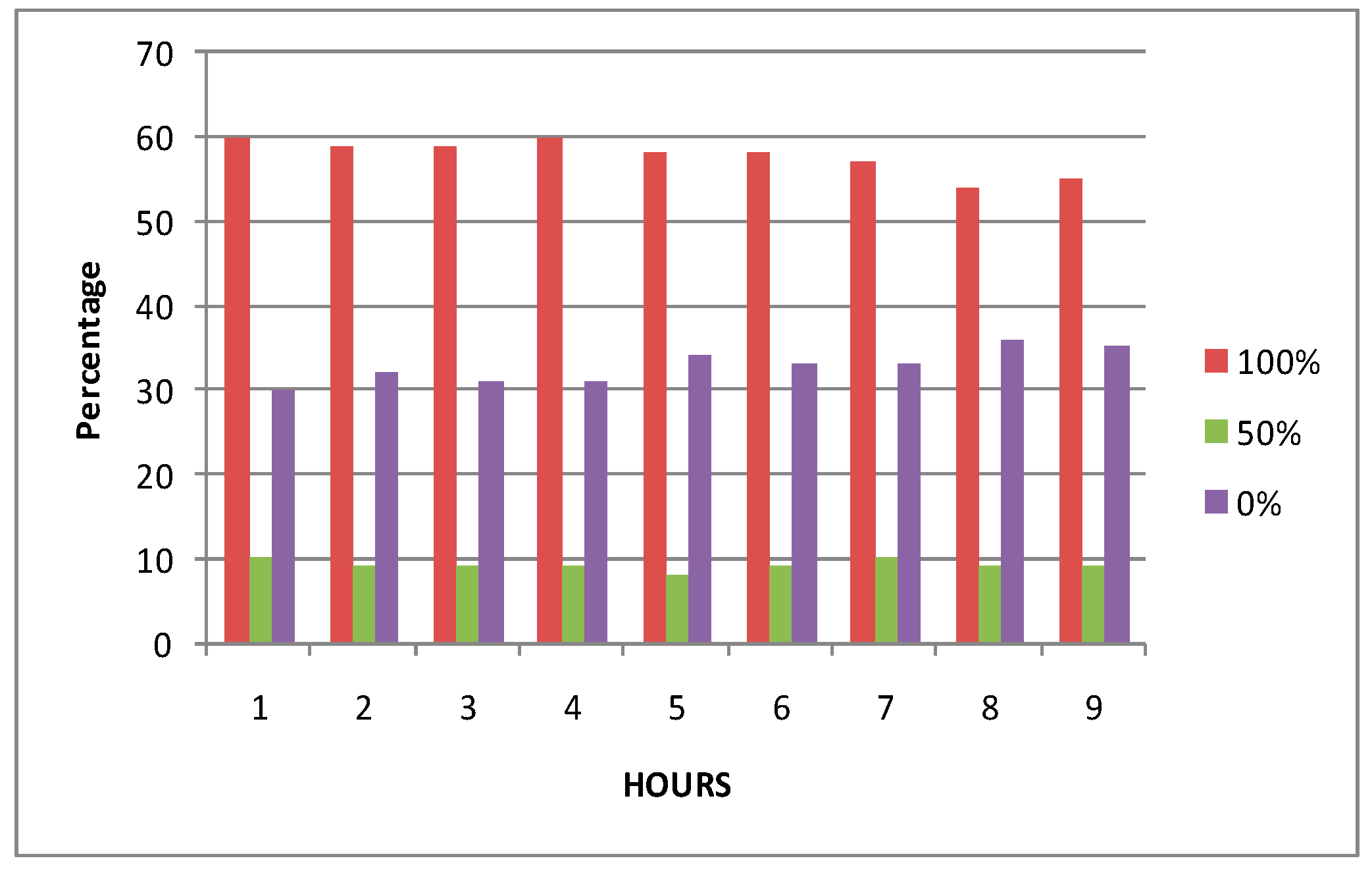A Verification Procedure for Terminal Aerodrome Forecasts †
Abstract
1. Introduction
2. Methodology
2.1. Wind Speed Verification
- For the transitional hour (in this case ‘07’), the METARs are compared against both versions of the TAF (i.e., the value before the BECMG and the value after the BECMG). For verification, the best version is kept—the one that yields the highest success rate.
- For the final hour (e.g., 08), the METARs are compared only against the final value specified in the TAF after the BECMG statement.
2.2. Wind Direction Verification
- If both METARs show a wind direction difference from the TAF that is smaller than the threshold, then the success rate is 100%.
- If only one of the two METARs has a difference smaller than the threshold, the success rate is 50%.
- If neither of the METARs falls within the threshold, the success rate is 0%.
2.3. Weather Phenomena Verification
- In case of PROB40 TEMPO RA or TEMPO RA (rain): If at least one occurrence of RA is observed, but does not cover at least half of the TEMPO period, the TEMPO statement is categorized as ‘PARTLY CORRECT’. If at least half of the METARs within the specified period show RA, the TEMPO statement is considered ‘CORRECT’.
- In case of PROB30 TEMPO: If at least one occurrence of a forecast phenomenon is observed, the TEMPO statement is categorized as ‘CORRECT’. For any ‘PROB40/30 TEMPO RA’ version: If no METAR shows RA during the period, the result is ‘FALSE ALARM’. If a phenomenon is not predicted in the TAF, this counts as a ‘MISS’.
2.4. METAR-TAF Phenomena Correspondence
2.5. Visibility Verification
3. Results
4. Conclusions
Author Contributions
Funding
Institutional Review Board Statement
Informed Consent Statement
Data Availability Statement
Conflicts of Interest
Appendix A
References
- International Civil Aviation Organization. Annex 3—Meteorological Service for International Air Navigation, 20th ed.; incorporating Amendment 81, applicable 28 November 2024; International Civil Aviation Organization: Montreal, QC, Canada, 2018. [Google Scholar]
- World Meteorological Organization (WMO). Manual on Codes: International Codes, Volume I.1—Part A: Alphanumeric Codes; WMO-No. 306; World Meteorological Organization (WMO): Geneva, Switzerland, 2019. [Google Scholar]
- Novotny, J.; Dejmal, K.; Repal, V.; Gera, M.; Sladek, D. Assessment of TAF, METAR, and SPECI Reports Based on ICAO ANNEX 3 Regulation. Atmosphere 2021, 12, 138. [Google Scholar] [CrossRef]
- Mahringer, G. Terminal aerodrome forecast verification in Austro Control using time windows and ranges of forecast conditions. Meteorol. Appl. 2008, 15, 113–123. [Google Scholar] [CrossRef]
- Prezerakos, N.G.; Prezerakos, H.N.; Michaelides, S.C. A verification method for aerodrome forecasts. Meteorol. Mag. 1991, 120, 31–35. [Google Scholar]
- Available online: https://www.cawcr.gov.au/projects/verification/ (accessed on 1 July 2025).
- World Meteorological Organization (WMO). Guide to the Verification of Operational Forecasts; WMO-No. 485; WMO: Geneva, Switzerland, 2015. [Google Scholar]
- Jolliffe, I.T.; Stephenson, D.B. Forecast Verification: A Practitioner’s Guide in Atmospheric Science, 2nd ed.; Wiley-Blackwell: Chichester, UK, 2012. [Google Scholar]

| TAF | METAR |
|---|---|
| RA (Rain) | RA |
| RA | TSRA (Thunderstorm-Rain) |
| RA | SHRA(Shower Rain) |
| RA | DZ(Drizzle) |
| TSRA | TSRA |
| TSRA | SHRA |
| TSRA | TS |
| SHRA | RA |
| SHRA | TSRA |
| SHRA | SHRA |
| SN (Snow) | SN |
| SN | SNRA (Snow Rain) |
| Category | Meters |
|---|---|
| 1 | 9999= >5000 |
| 2 | 5000= >3000 |
| 3 | 3000= >1500 |
| 4 | 1500= >800 |
| 5 | 800= >600 |
| 6 | 600= >350 |
| 7 | 350= >150 |
| 8 | 150= >000 |
| Score | RA/SHRA | TSRA |
|---|---|---|
| Frequency Bias (FBI) | 1.5 | 3.2 |
| Probability of Detection (POD) | 0.71 | 0.88 |
| False Alarm Rate (FAR) | 0.54 | 0.73 |
| Equitable Threat Score (ETS) | 0.24 | 0.22 |
| Accuracy | 0.75 | 0.86 |
| Heidke Skill Score (HSS) | 0.4 | 0.36 |
Disclaimer/Publisher’s Note: The statements, opinions and data contained in all publications are solely those of the individual author(s) and contributor(s) and not of MDPI and/or the editor(s). MDPI and/or the editor(s) disclaim responsibility for any injury to people or property resulting from any ideas, methods, instructions or products referred to in the content. |
© 2025 by the authors. Licensee MDPI, Basel, Switzerland. This article is an open access article distributed under the terms and conditions of the Creative Commons Attribution (CC BY) license (https://creativecommons.org/licenses/by/4.0/).
Share and Cite
Boucouvala, D.; McCooey, D. A Verification Procedure for Terminal Aerodrome Forecasts. Environ. Earth Sci. Proc. 2025, 35, 30. https://doi.org/10.3390/eesp2025035030
Boucouvala D, McCooey D. A Verification Procedure for Terminal Aerodrome Forecasts. Environmental and Earth Sciences Proceedings. 2025; 35(1):30. https://doi.org/10.3390/eesp2025035030
Chicago/Turabian StyleBoucouvala, Dimitra, and David McCooey. 2025. "A Verification Procedure for Terminal Aerodrome Forecasts" Environmental and Earth Sciences Proceedings 35, no. 1: 30. https://doi.org/10.3390/eesp2025035030
APA StyleBoucouvala, D., & McCooey, D. (2025). A Verification Procedure for Terminal Aerodrome Forecasts. Environmental and Earth Sciences Proceedings, 35(1), 30. https://doi.org/10.3390/eesp2025035030






